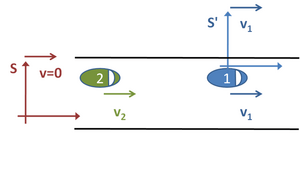Frame of reference facts for kids
A frame of reference is like your viewpoint when you're watching something move. It's the background or the place you're standing that helps you figure out if an object is moving or staying still. For example, if you see a ball rolling down a street, you know it's moving because you're using the street, the buildings, or even the Earth itself as your frame of reference. All these things can be a frame of reference.
The most common frame of reference we use every day is the Earth, even though the Earth itself is always moving through space!
Contents
What is a Frame of Reference?
A frame of reference is simply a way to describe motion. Think about it: is a person sitting on a train moving?
- From your viewpoint inside the train, they are not moving relative to you or the train seats.
- But from someone standing outside the train station, that person is moving very fast along with the train.
Both viewpoints are correct, but they use different frames of reference.
Why Do We Need Frames of Reference?
We need frames of reference to make sense of how things move. Without one, it would be hard to say if something is truly moving or just appears to be. For example, if you're in a car moving at the same speed as another car next to you, it might look like the other car isn't moving at all, even though both cars are speeding down the road! Your car is your frame of reference in that moment.
Common Examples of Frames of Reference
- The Ground: When you walk or run, you usually think of yourself moving relative to the ground. The ground is your frame of reference.
- A Moving Vehicle: If you're on a bus, you might walk down the aisle. You're moving relative to the bus, but the bus itself is moving relative to the road.
- Space: When we talk about planets orbiting the Sun, we often use the Sun as our frame of reference.
Types of Frames of Reference
Scientists often talk about two main types of frames of reference: inertial and non-inertial.
Inertial Frames of Reference
An inertial frame of reference is one where objects that are not being pushed or pulled by any forces either stay still or keep moving at a steady speed in a straight line. Imagine you're in a car that's cruising smoothly on a straight highway at a constant speed. If you toss a ball straight up, it will come straight back down into your hand. This is because the car is acting like an inertial frame of reference. The laws of motion, like Isaac Newton's laws, work perfectly in these frames.
Non-Inertial Frames of Reference
A non-inertial frame of reference is one that is speeding up, slowing down, or changing direction. Think about being in a car that suddenly brakes, speeds up, or turns a corner. If you toss a ball up in a car that's turning, it won't come straight back down; it will seem to fly off to the side. This is because the car itself is accelerating, and you feel extra forces (like being pushed back into your seat when the car speeds up). The laws of motion look a bit different in these frames because of these extra "fake" forces.
Who Uses Frames of Reference?
Everyone uses frames of reference, even if they don't realize it!
- Scientists use them to study how planets move, how rockets fly, and how tiny particles behave.
- Engineers use them to design cars, planes, and roller coasters, making sure they are safe and work correctly.
- GPS systems use very precise frames of reference to figure out your exact location on Earth.
Understanding frames of reference helps us understand that motion isn't always as simple as it seems. It depends on where you're watching from!
See also
 In Spanish: Sistema de referencia para niños
In Spanish: Sistema de referencia para niños


